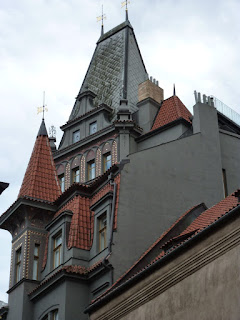 |
St. Nicholas from street level
|
 |
Interior; knock-out Counter-Reformation
Baroque to the hilt
|
 |
Altar
|
 |
Impressive dome
|
 |
Nave ceiling
|
 |
Organ
|
 |
Interesting pose, Vicki thought
|
 |
Skewering another Protestant
|
...recounts the retirement travels of Mark and Vicki Sherouse since 2008...in Asia and the Pacific, New Zealand, Europe, South America, and Africa, as well as the US and Canada. Our website, with much practical information, is: sites.google.com/site/theroadgoeseveron/.Contact us at mark.sherouse@gmail.com or vsherouse@gmail.com.
 |
St. Nicholas from street level
|
 |
Interior; knock-out Counter-Reformation
Baroque to the hilt
|
 |
Altar
|
 |
Impressive dome
|
 |
Nave ceiling
|
 |
Organ
|
 |
Interesting pose, Vicki thought
|
 |
Skewering another Protestant
|
 |
But first, today's wedding photo shoot shot, in the castle square (we see one nearly every day) |
 |
The Czech crown, etc.; hasn't been used for quite a while |
 |
Interior of St. George's Basilica, a 10th century chapel on the premises |
 |
The basilica itself |
 |
View out the state rooms' windows (the usual no pix policy enforced) |
 |
The view: the domes and roof of St. Nicholas', in Mala Strana, below the castle hill |
 |
The Moldau and Charles Bridge below |
 |
The City of Spires, it's called |
 |
Ditto |
 |
West facade and towers; flaming Gothic, as
you can see
|
 |
Interior
|
 |
Beautiful windows (Mucha's the best, we
thought; see earlier post)
|
 |
Stained light on the floor
|
 |
Ceiling; note tracery at top of windows
|
 |
Tomb of St. Vitus; the original church was
built around it in the 10th century
|
 |
A royal tomb
|
 |
Rose window
|
 |
St. Wenceslas chapel
|
 |
East side, buttresses, spires and tower
|
 |
You may never have heard of Mucha, but you have seen his work and that of many imitators; the Style Mucha is nearly synonymous with Art Nouveau...slinky women, flowers, extravagant ornamentation |
 |
Typical |
 |
The Mucha window in St. Vitus' Cathedral |
 |
The Medieval Tower next to the Municipal
House
|
 |
Smetana Hall, the great concert hall in the Municipal House
|
 |
Entry oramentation for the Municipal House
|
 |
One of the several gorgeous restaurants
|
 |
Another
|
 |
Downstairs, the Czech dining room/beer hall, incredible
paneling
|
 |
Glass-work like this everywhere
|
 |
Nearby, towers of the Church of Our Lady of Tyn
|
 |
The massive statue to Jan Hus, in the main square; Hus was
the earliest of Protestant reformers, burnt at the stake after
his capture (by deceit) and refusal to recant
|
 |
Rathaus tower and the astronomical clock;
the crowd was wowed, but we've seen better...
|
 |
Not least of which is the Old New
Synagogue, Europe's oldest surviving
synagogue
|
 |
Built in the 13th century, small but identifiably Gothic in
architecture; only very slightly enlarged and remodeled
from that time
|
 |
More interior
|
 |
Sanctum sanctorum, so to speak
|
 |
Still more interior
|
 |
Slits cut in the thick wall so the women-folk could peer in
|
 |
Medieval donation box
|
 |
Flag in the shape of the hats Jews were forced to wear
|
 |
Another, younger synagogue
|
 |
With clocks
|
 |
We're still pondering this one, although it is clear the
woman on the right is listening to an iPod
|
 |
A glimpse into the old Jewish cemetery,
where some 100,000 are buried, under
12,000 headstones; they were allotted very
little space
|